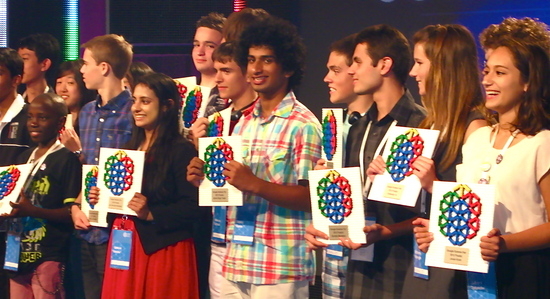By Malachi Segers and Maya Godfrey

Yassine Bouanane has been a coding whiz since before he was a teenager -- at 12, he started developing his own web sites. But then last summer, the 17-year-old from Quebec decided he would engineer a way to squeeze more energy out of solar panels, and he didn’t know the first thing about electronics.
"It was completely new to me," said Bouanane. "I had to learn everything from the beginning."
He began by reading articles on the Internet and watching videos on YouTube. He started spending a lot of time in his garage, tinkering with one prototype after another. Months of hard work got him a fourth prototype -- a solar panel that senses the sun's location in the sky and follows it throughout the day to produce over 35 percent more energy than standard solar panels.
It also got him a trip to Palo Alto, Calif. as a finalist in the 2012 Google Science Fair, which held its award ceremony this week.
Now in its second year, Google's contest highlights the breakthroughs of 13- to 18-year-olds who submit online entries from around the world and celebrates several of them with top prizes. Or, as last year's grand prize winner Shree Bose told the ceremony audience, "It turns its winners into scientific rockstars."
A third of last night's would-be rockstars, like Bouanane, were also makers. Of the 15 final projects, five of them involved inventing a mechanical system and building prototypes from scratch. And while the overall winner Brittnay Wenger's project exists only in the cloud (she developed an artificial neural network for diagnosing breast cancer), the project that won the 13-14 division turned invisible sound waves into a more physical experience. Jonah Kohn, 14, from San Diego, invented a way for people with hearing disabilities to, well, hear -- his device translates sound into frequencies you can listen to as vibrations on other parts of your body.
During the ceremony, Richard DeVaul of the Google X Lab emphasized the fun of doing something you don't already know how to do. He told the finalists about years ago making a bulky wearable computer that was a cool, but not-so-functional precursor to the sleek Google Glass prototype that the company's secret lab demoed this year.
"It's the process of constructive play," said DeVaul. "That's how you learn to do science, that's the essence of science."
Rather than mere refinements or improvements to existing technology, the inventions of the Google finalists represented entirely new ways to fix major problems. While industrial solar panels already follow the sun across the sky, they're pre-programmed to do it; Bounane's panels actually track the sun. The technology could have a big impact for solar energy on vehicles and in poorer countries where people's homes are temporary and they must take their energy source with them.
Solving problems in developing countries was the whole point of 16-year-old finalist Sabera Talkuder's water purifier. Coming from Los Gatos, Calif., Talukder got her idea on a family trip to Bangladesh. She discovered that it was very difficult for people in small villages there to access clean drinking water, so she decided to invent a solution. Although, like Bounane, she first had a lot to learn.
"It was all new to me," said Talukder. "I developed the entire apparatus from research I did off of the Internet, and talking to different people in the field." But starting from scratch was part of the idea, since she knew the people whose tainted water she had sampled wouldn't have many materials to work with. "These villages need to clean the water cheaply and portably," said Talukder.
The materials needed to make her water purifier are few and simple: cotton, sand, a jute bag, a 5-gallon barrel, and a power system -- solar panels, a car battery and an inverter that is hooked up to a UV light. Talukder said the prototype is still developing but that "it can’t be perfect because the people in these countries don’t need perfection, they need a solution to clean drinking water now."
There were also more high-tech makers among finalists, including Melvin Zammit, a 17-year-old from Malta determined to revolutionize 3D technology. The problem with the standard stereoscopic tech is that a large portion of the population has cataracts and other eye problems and can't see the optical illusion. Zammit built several devices that move LEDs very rapidly to create a layered or "real" 3D effect. "It's like a hologram," said Zammit.
Zammit, who has also built a tic-tac-toe-playing robot and is developing Android apps, is looking for his next project. "I really want to learn about electronic brains and stuff like that," he said. When asked if he considered himself part of a growing maker movement, he answered: "Yes, definitely."
Originally published on Youthradio.org, the premier source for youth generated news throughout the globe.
Youth Radio/Youth Media International (YMI) is youth-driven converged media production company that delivers the best youth news, culture and undiscovered talent to a cross section of audiences. To read more youth news from around the globe and explore high quality audio and video features, visit Youthradio.org